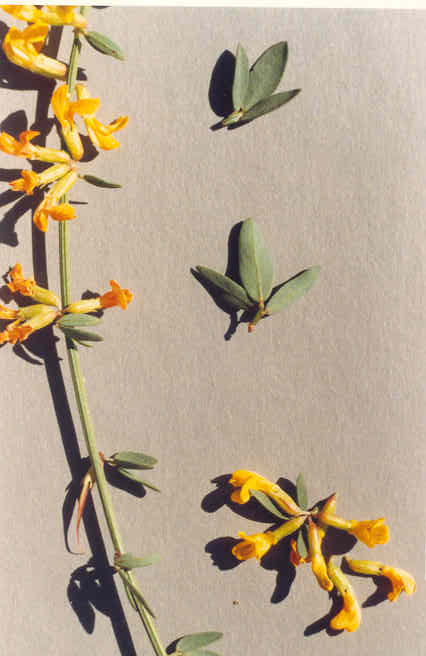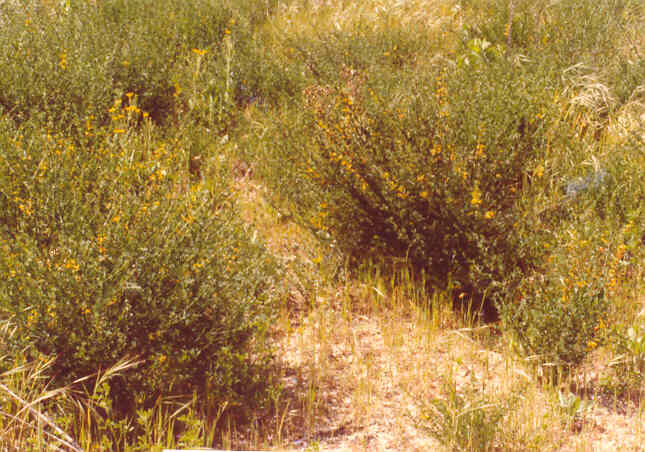
 |
Lotus scoparius (Nutt.) Ottley var. scopariusFabaceae (Pea Family)NativeDeer-WeedCalifornia BroomCoastal Deer Weed |
February Photo
Plant Characteristics:
Bushy, suffruticose, +/- suberect perennial, 2-12 dm. high, with rather virgate
green branches or +/-silky; lfts. mostly 3, oblong to oblanceolate, 4-10 or more
mm. long; umbels sessile in axils or short-peduncled, 1-5 fld.; calyx commonly
3mm. long; corolla 7-10 (-12) mm. long, yellow or tinged red, the wings as long
as keel; pods well exceeding calyx, to 1.5 cm. long, glabrous, tapering to a
subulate beak; seeds 2-3, dark brown.
Habitat:
Common on dry slopes and fans, especially as a successional stage after
burns, below 5000ft.; Coastal Sage Scrub, Chaparral, Coastal Strand, etc.;
cismontane from L. Calif. n. to Humboldt Co.; Channel Ids.
March-Aug.
Name:
Lotus is from the Greek and was
originally applied to a fruit which was said to make those who tasted it forget
their homes. Scoparius means broom-like and refers to another wide-spread plant
in the same family. (Dale 111).
Scoparius also describes the
shape of deerweed's broomlike bushes. (John
Johnson).
General:
Occasional in the study area, there was a large field of this plant on
the North Star Flats, however, the County of Orange has disked this area the
past few years and destroyed nearly all of the large plants.
Photographed on the North Star Flats and the Santa Ana Heights Flats.
(my comments).
This is one of the many species of plants that thrive after fire has
ravaged chaparral-covered slopes. It
vigorously persists for several years, although it is choked out of most areas
by the thick brush that eventually returns.
Like most other members of the Pea Family, it has the capacity to enrich
the soil with nitrogen. (Spellenberg
500). Both deer and stock are said to feed on
this plant when pasturage is scarce, though they rarely touch it when other food
is plentiful. It produces ample
nectar and is a great favorite with the bees.
(Dale 111).
The diversity of herb species in the first year following a fire is
remarkable. Up to twenty-five
species or more may be found in a single square meter.
Strangely, California is the only one of the five Mediterranean-type
ecosystems with such a diverse assemblage of annual fire successional shrubs.
Comparable communities to what we call chaparral in California are termed
maquis or garrique
in southern Europe, matorral in
central Chile, fynbos in South Africa,
and kwongan or heath in Australia.
A variety of short-lived subshrubs germinate the first year following a
fire, and these form an important element of stand structure in the first few
years of succession. Good examples of these are Lotus
scoparius, Dendromecon rigida, and species of Eriodictyon. These
commonly become senescent within five to ten years following a fire and are
replaced in coverage by a rapidly closing canopy of the original pre-fire shrub
dominants. There are two principal
ways in which chaparral shrubs respond to fire.
One group of species, including the majority of chaparral genera,
resprouts from underground root crowns. This
trait appears to be an ancestral one in vascular plants where it is of adaptive value, not only following fire,
but also after damage by frost, drought or heavy grazing.
With one notable exception, species that resprout do not have seeds that
are stimulated to germinate following a fire.
The other mode of response to fire is non-sprouting, with reestablishment
through germination of seeds. Seed
pools in these species are stimulated to germinate by the heat of the fire (and
possibly by chemical effects as well). The
one exception to the dichotomy between resprouting and reseeding occurs in
chamise which utilizes both strategies. Chaparral
soils are typically nutrient-deficient, particularly in nitrogen.
It is not surprising, therefore, to find a number of chaparral shrubs
that have evolved nitrogen-fixing symbioses.
Species of Ceanothus and the legume Lotus
scoparius are important nitrogen-fixers in post-fire successional sequences
in chaparral. Chaparral fires cause
major losses of nitrogen from these ecosystems due to volatilization of
nitrogenous compounds in plant tissues and soil organic matter.
Normal inputs of nitrogen in dry or wet forms are only a few pounds per
ten thousand square miles per year, much too slow to allow replenishment of
pre-fire levels of system nitrogen. Symbiotic
nitrogen fixation by shrubs and herbaceous legumes is the critical element in
restoring nitrogen pools in the early years following a fire.
Although fire reduces the total amount of nitrogen in chaparral
ecosystems, availability of the inorganic forms of nitrogen that plants can use
directly is increased. As a result,
post-fire conditions for growth are generally favorable.
Increasing levels of gaseous and particulate pollutants containing
nitrogen are now present in many parts of California.
Dry and wet deposition of these pollutants into chaparral ecosystems is
clearly causing greatly enhanced levels of nitrogenous inputs to these systems.
In the mountains near Los Angeles, such inputs are estimated to be ten
times or more the natural levels. (Rundel,
Philip W. "Structure and Function in California Chaparral".
FREMONTIA, A Journal of the California Native Plant Society.
October l986. pp. 4-10). For
additional information on these subjects see Heteromeles
arbutifolia, Encelia californica,
Artemisia californica, Eriogonum
fasciculatum, Rhus
integrifolia, Bloomeria crocea,
Phacelia ramosissima, Eriophyllum confertiflorum, and Lolium
perenne. The Cahuilla Indians,
inhabitants of the San Bernardino and San Jacinto Mountains and the Colorado
Desert, used L. scoparius as a
material in house construction. (Bean and Saubel 87).
Perhaps 150 spp., of all continents, but mostly in N. Hemisphere.
(Munz, Flora So. Calif. 444).
Text Ref:
Collins 115; Hickman, Ed. 620; Munz, Calif.
Flora 849; Munz, Flora So. Calif.
449; Roberts 24.
Photo Ref:
Dec 3 83 # 23; Feb 1 86 # 11,13.
Identity: by R. De Ruff.
Computer Ref: Plant Data 75.
Have plant specimen.
Last edit 1/17/03.
 |
March Photo